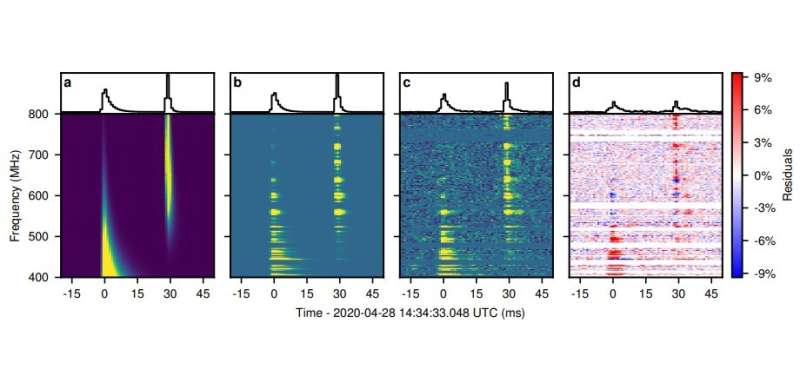SGR 1935+2154: dynamic spectra and band-averaged time-series of burst models. Credit: Scholz et al., 2020.
Using the Canadian Hydrogen Intensity Mapping Experiment (CHIME) radio telescope, astronomers have detected a bright, millisecond-duration radio burst from a galactic magnetar known as SGR 1935+2154. The discovery of such an extremely intense event, reported in a paper published May 20, could be important for improving the understanding of the origin of fast radio bursts (FRBs).
Magnetars are neutron stars with extremely strong magnetic fields, more than a quadrillion times stronger than the magnetic field of Earth. Decay of magnetic fields in magnetars powers the emission of high-energy electromagnetic radiation, for instance, in the form of X-rays or radio waves.
FRBs are intense bursts of radio emission lasting milliseconds and showcasing the characteristic dispersion sweep of radio pulsars. The physical nature of these bursts is unknown, and astronomers have considered a variety of explanations, including synchrotron maser emission from young magnetars in supernova remnants, and cosmic string cusps.
Located some 30,000 light years away in the Vulpecula constellation, SGR 1935+2154 is a galactic magnetar known to exhibit transient radio pulsations. Recently, it entered a period of unusually intense X-ray burst activity, and almost immediately, a team of astronomers led by Paul Scholz of the University of Toronto, Canada, started to observe this pulsar with CHIME. This resulted in the detection of a two-component bright millisecond radio burst from SGR 1935+2154 on April 28, 2020, similar to FRBs observed at extragalactic distances.
"The burst was detected simultaneously in 93 of the 1,024 CHIME/FRB formed beams, indicating an extremely bright event," the astronomers wrote in the paper.
The detected event consisted of two sub-bursts lasting 0.585 and 0.355 milliseconds, with the second occurring approximately 0.03 seconds after the first one. The dispersion measure of two burst components was found to be about 332.72 pc/cm3.
The fluence of the two sub-bursts was measured to be 480 and 220 kJy ms. The researchers noted that such values, together with the estimated distance to SGR 1935+2154, indicate a 400–800 MHz burst energy at a level of 30 decillion ergs, which is brighter than those of any radio-emitting magnetar known to date.
According to the paper, the new radio burst was identified when SGR 1935+2154 was in an extended active phase in which hundreds of high-energy bursts were reported. The researchers noted that the burst described in the study is by far the most radio-luminous such event detected from any magnetar in the Milky Way galaxy.
The astronomers ponder the possibility that the newly detected burst could be an FRB. First of all, the morphology of the radio burst resembles that of FRBs, in particular, the durations of its subcomponents are typical of the widths of bursts from 18 repeating FRB sources discovered by CHIME. Moreover, this burst was found to be only one to two orders of magnitude below the observed burst energies for typical FRBs, but it could have similar energies to some identified FRBs if they were at their nearest possible distance.
Whether the newfound radio burst from SGR 1935+2154 is an FRB remains an open question, but the researchers say that their detection may be helpful in filling the energy gap between the most luminous galactic sources and extragalactic FRBs.
"This event thus bridges a large fraction of the radio energy gap between the population of galactic magnetars and FRBs, strongly supporting the notion that magnetars are the origin of at least some FRBs," the authors of the paper concluded.
More information: A bright millisecond-duration radio burst from a Galactic magnetar, arXiv:2005.10324 [astro-ph.HE] arxiv.org/abs/2005.10324
© 2020 Science X Network
























